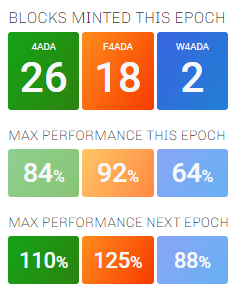On a few occasions, we noticed in recent weeks that the python script we were using to predict future block assignments, seemed to produce inaccurate results. We have adopted a different process to calculate upcoming blocks, which now reliably provides expected pool performance one day before epoch-start.
After noticing in this epoch (249) that an orphaned 4ADA block did not appear in our slot leadership schedule for this pool, we went to the bottom of this and subsequently adopted Andrew Westberg’s excellent CNCLI to predict upcoming slot leadership schedules.
From now on, every last day of the epoch, we will post on our homepage the upcoming maximum performance expectations for each of our pools, as shown below:
Below the blocks minted so far this epoch, you will find the max performance expectation for the current epoch. And, only on the last day of every epoch, you will also see what the next epoch is going to bring.
The max performance is calculated based on two parameters:
- Number of blocks for the pool to mint during the epoch, based on the slot leadership schedule
- Theoretical number of blocks the pool is entitled to, given its active stake
So, max performance is calculated by dividing the number of assigned blocks by the theoretically entitled number of blocks. This percentage represents the maximum possible performance, and realistically will end up slightly lower, given the 5% chance of orphan blocks. (As a reminder, on average, every 10th block is assigned to two or more pools with random outcome, resulting in approx. 1 block lost once every 20 blocks, again, on average.)
Since the calculated numbers for 4ADA in epoch 249 were wrong, these have been adjusted in the table above. The numbers for 249 are therefore somewhat disappointing for 4ADA, but fortunately will be made up for in the next epoch with +10% more blocks coming through!

Leave A Comment